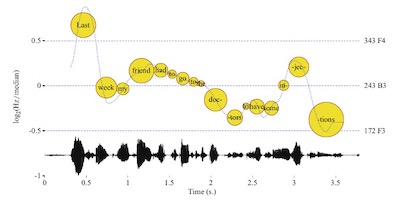|

Di Liu
|
|

Marnie Reed
|
Why do we need Complexity Theory?
Evolutionary developments in second language pronunciation theory, including the intelligibility principle, the balancing of segmental and suprasegmental features, and the application of technology have profoundly and fundamentally changed pronunciation teaching in the past few decades.
Teaching pronunciation, however, remains challenging. Among the most pressing issues is how to promote the application of classroom learned knowledge and skills, particularly suprasegmental features such as intonation, stress, and rhythm, in spontaneous production. With respect to intonation, a feature that affects meaning and pragmatic functions, the standard pedagogic approach is imitation of a model. However, as Gilbert (2014) stated, “students will rarely tell the teacher that they feel silly speaking this way, and the result will be that they may walk out of the class without having accepted the system at all. Or they may think intonation is simply decorative” (p. 125). To promote carry-over to learners’ daily communication, two tasks need to be completed:
- Learners need to be aware and convinced of the importance of intonation;
- Learners need to be able to apply classroom learned materials in spontaneous speech.
To address the first task, teachers need to enhance learners’ metalinguistic awareness of intonation’s discourse and pragmatic functions. Pre-instruction surveys can establish a baseline of learners’ beliefs. Sample metalinguistic survey questions relating to these functions, adapted from Jones, Liu, and Reed (forthcoming) include the following true/false statements:
- intonation allows speakers to signal an implied contrast without actually stating it;
- intonation can change the meaning of what is said;
- intonation allows speakers to convey their meaning with fewer words;
- intonation allows speakers to convey their meaning without actually saying what they mean.
Post-instruction summative assessment can include the pre-instruction survey to determine whether and the extent to which metalinguistic awareness has changed, coupled with metacognitive surveys to determine implementation of strategies to assess skill progression in understanding message meaning. Sample post- instruction survey questions use a 3-part Agree/Not Sure/Disagree Likert scale:
- I notice English intonation – the rise and fall in pitch that makes words sound higher or lower;
- I pay attention to intonation, and I use it to interpret a speaker’s meaning.
Addressing the complex and dynamic nature of language is key to making classroom learned knowledge and skills applicable in spontaneous speech. Specifically, we need to acknowledge that:
- Segmental and suprasegmental features are not used in isolation;
- The change of one variable will lead to changes of the whole system.
When producing spontaneous speech, learners must juggle multiple components including consonants and vowels, intonation, pitch, duration, and pauses along with various linguistic variables such as vocabulary and grammar. Learners must also use these features in ways that are consistent with meaning, information structure, and pragmatic functions at the discourse level. Hence ability to reproduce a particular feature in a classroom is not the equivalent of ability to use the same feature effectively in spontaneous speech.
What is Complexity Theory?
Complexity Theory (CT) views language development and the authentic use of language ascomplex and dynamic processes involving multiple interwoven and interacting variables. As Larsen-Freeman (2017) stated, “it is from the components and their relationships that the system we are trying to understand emerges. If we isolate components artificially, we lose the essence of the phenomena we are attempting to describe” (p. 29).
In pronunciation teaching, complexity needs to be addressed at both the structural level, often referred to as structural complexity, and the functional level, referred to as functional complexity (Liu & Reed, 2021). For instance, the features associated with sentence stress – pitch, duration, intensity, and vowel quality of the stressed word or syllable – constitute structural complexity. At the functional level, learners also must be able to use sentence stress to carry meaning and signal information structure. While information structure and pragmatic functions are language universal, the mapping between pronunciation and these aspects is usually language specific. Establishing this mapping among pronunciation, meaning, information structure, and pragmatic functions is thus another level of complexity that needs to be addressed.
Viewing pronunciation from a Complexity Theory (CT) perspective allows us to better understand and assess teaching outcomes. For instance, from a CT perspective, the imitation-repetition technique has limitations:
- Learners may not be able to discriminate the difference between the target production and their own production;
- Learners may not be able to simultaneously control all the variables while producing spontaneous language;
- Learners may not map L2 pronunciation with meaning, information structure, and pragmatic functions.
Given the complexity of language use and language acquisition, a key question is, “How can teachers manage the complexity and dynamic interaction of multiple variables in pronunciation teaching?” Technology can assist teachers in addressing this question.
High-Variability Pronunciation Training
High-Variability Pronunciation Training (HVPT) promotes learners’ perception of speech by introducing variation to the input (Thomson, 2018). HVPT is consistent with CT as it moves from a single, static model to a collection of models that represent language in use and that capture various characteristics of the target production. The following technological resources can be used to provide HVPT.
English Accent Coach (https://www.englishaccentcoach.com/) is a website that assesses English learners’ perception of segments (consonants and vowels). Users hear production from various speakers and need to click on the IPA symbols that correctly represent the sounds they hear. The website can generate a report identifying the sounds that are most challenging in perception for users based on the correction rate of the perceptual task. Teachers may use English Accent Coach as a pre-assessment or a tool to keep track of learners’ development in segmental perception.
YouGlish.com (https://youglish.com) offers numerous videos with transcripts and authentic use of language. The website contains a large amount of searchable video clips, offering HVPT at both the segmental and suprasegmental level. To use the website for lower proficiency learners, teacher may adjust the playback speed and use the built-in translation tools, such as Google Translate, DeepL, and Reverso.
Speech Visualization
The transient nature of speech has made it particularly difficult for teachers to analyze and provide feedback to learners regarding their speech production. Visualization thus has long been acknowledged to be an effective technique in improving learners’ pronunciation (Levis & Pickering, 2004). Its primary limitation is that the pitch track is mostly visualized in isolation.
ProZed allows users to integrate multiple features (pitch, syllables, and syllable duration) when visualizing speech (Hirst, 2015), offering a potentially productive direction for speech visualization from a CT perspective. For instance, in Figure 1, the blue line represents the modeling of fundamental frequency (F0); the duration of the syllables is represented by the sizes of the circles.
To visualize speech with ProZed, teachers need to use Praat (Boersma & Weenik, 2021) to record and annotate speech, making it difficult to visualize spontaneous speech in the classroom. We envision that, with the development of Natural Language Processing (NLP), a speech visualization tool for spontaneous production will be available for teachers in the near future.

Figure 1. ProZed Prosody Display (adapted from Hirst, 2015)
Automated Speech Recognition (ASR)
Intelligibility, measured by the percentage of words correctly transcribed by native speakers, is difficult to implement in pronunciation teaching. In casual settings, conversational partners may not point out learners’ pronunciation mistakes. In classroom settings, teachers may find it difficult to provide instant, personalized intelligibility feedback.
Automated Speech Recognition (ASR) provides a potential solution by offering immediate and accessible transcripts, which can be viewed, to some degree, as indicators of learners’ intelligibility (McCrocklin & Edalatishams, 2020). ASR has been integrated into multiple tools including Google Voice Typing and Zoom live transcript. Research shows that learners are able to make improvement based on ASR transcripts, especially at the segmental level.
Conclusion
Acknowledging the complex and dynamic nature of pronunciation is a crucial step in promoting spontaneous production in L2 pronunciation teaching. Technological advances offer practical solutions in addressing the complexity of the L2 pronunciation system. It is recommended that teachers organically and systematically integrate current technological resources into their curricula, and adopt additional technological resources as they are developed in order to facilitate monitoring and managing the complex and dynamic system of pronunciation.
References
Boersma, P. & Weenink, D. (2021). Praat: doing phonetics by computer [Computer program]. Version 6.1.50, retrieved 20 June 2021 from http://www.praat.org/
Gilbert, J. (2014). Myth 4: Intonation is hard to teach. In L. Grant (Ed.), Pronunciation myths: Applying second language research to classroom teaching (pp.107-136). Ann Arbor, MI: University of Michigan Press. https://doi.org/10.3998/mpub.4584330
Hirst, D. J. (2015). ProZed: a speech prosody editor for linguists, using analysis-by-synthesis. In Hirose, K., & Tao, J. (Eds.), Speech Prosody in Speech Synthesis: Modeling and generation of prosody for high quality and flexible speech synthesis (pp. 3-17). Berlin: Springer.
Jones, T., Liu, D., & Reed, M. (forthcoming). Phonetics in language teaching. In D. Deterding (Ed.), Elements in Phonetics. Cambridge: Cambridge University Press.
Larsen-Freeman, D. (2017). Complexity theory: The lessons continue. In L. Ortega & Z. Han (Eds.), Complexity theory and language development: In celebration of Diane Larsen-Freeman (pp. 11-50). Philadelphia: John Benjamins.
Levis, J., & Pickering, L. (2004). Teaching intonation in discourse using speech visualization technology. System, 32(4), 505-524.
Liu, D., & Reed, M. (2021). Exploring the complexity of the L2 intonation system: An acoustic and eye-tracking study. Frontiers in Communication. 6:627316. Doi:10.3389fcomm.2021.627316
McCrocklin, S., & Edalatishams, I. (2020). Revisiting Popular Speech Recognition Software for ESL Speech. TESOL Quarterly, 54(4), 1086-1097.
Thomson, R. I. (2018). High variability [pronunciation] training (HVPT): A proven technique about which every language teacher and learner ought to know. Journal of Second Language Pronunciation, 4(2), 208-231.
Di Liu is Assistant Professor of Instruction at Temple University where he is pursuing a post-doctoral MS in Information Science & Technology. He is coordinator of the TESOL M.Ed. and ELT English Language Teaching Certificate programs. His research focuses on Complexity Theory, Applied Phonology, and Technology-Enhanced Language Teaching.
Marnie Reed is Professor of Education and director of the graduate TESOL program at Boston University where she teaches linguistics and applied phonology. She is co-editor, with John Levis, of the Wiley Handbook of English Pronunciation and co-editor, with Tamara Jones, of the forthcoming TESOL Press Listening in the Classroom. | 
